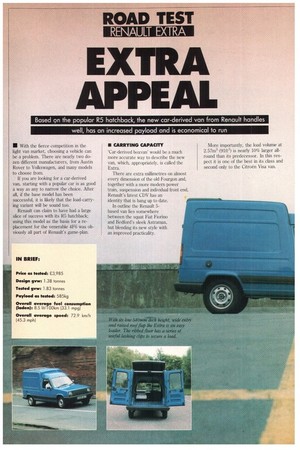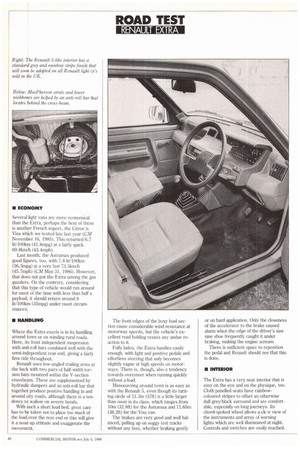EXTRA APPEAL
Page 56

Page 57

Page 58

Page 59

If you've noticed an error in this article please click here to report it so we can fix it.
Based on the popular R5 hatchback, the new car-derived van from Renault handles well, has an increased payload and is economical to run
IN With the fierce competition in the light van market, choosing a vehicle can be a problem. There are nearly two dozen different manufacturers, from Austin Rover to Volkswagen, and many models to choose from.
If you are looking for a car-derived van, starting with a popular car is as good a way as any to narrow the choice. After all, if the base model has been successful, it is likely that the load-carrying variant will be sound too.
Renault can claim to have had a large slice of success with its R5 hatchback; using this model as the basis for a replacement for the venerable 4F6 was obviously all part of Renault's game-plan. • CARRYING CAPACITY 'Car-derived boxvan' would be a much more accurate way to describe the new van, which, appropriately, is called the Extra.
There are extra millimetres on almost every dimension of the old Fourgon and, together with a more modern power train, suspension and individual front end, Renault's latest CDV has an identity that is bang up to date.
In outline the Renault 5based van lies somewhere between the squat Fiat Morino and Bedford's sleek Astramax, but blending its new style with an improved practicality.
More importantly, the load volume at 2.57m3 (91ft3) is nearly 10% larger allround than its predecessor. In this respect it is one of the best in its class and second only to the Citroen Visa van.
Its payload, too, has increased — by 22% to a very useful 575kg and, although this is only 50kg less than the Astramax, it is 120kg behind that of Austin Rover's Maestro van.
The rear is an attractive blend of the old and the new, with Renault reverting to double doors, each hinged to allow 90degree opening on sliding restraints. With these released and folded down out of the way, both doors swing back to a full 180 degrees.
Renault has retained the roof flap as a ,U20 option on certain models. This is secured in the closed position on to a locking bar which is hinged on the left just below the roofline and held in a bracket on the right.
With the flap raised and the doors fully open, the Extra with its 540rrim loadbed height has to be one of the easiest of vehicles to load into.
A series of tie-down clips in the ribbed floor is useful as are the two upright bars fitted behind the driver's seat. There is no bulkhead but the body stampings would allow a partition to be easily attached.
The main purpose of the roof flap is to allow long awkward items, such as ladders, pipes or plastic guttering to protrude through the opening.
More space is gained simply by folding the passenger seat forward and down to the floor.
Both rear doors have large, upright heated windows that provide good clear
• DRIVELINE
There are three Extra models: a 35kW (47hp) 1.1-litre petrol-engined version with standard four-speed gearbox (a fivespeed unit is an option); a 45kW (60hp) 1.4-litre petrol; and a 41kW (55hp) 1.6litre diesel model A five-speed box is standard on the two latter models.
Renault has now fallen into line with other manufacturers and fits a transversely mounted engine. Like many who have gone down these paths, Renault has refined the idea to a fine art.
The gearbox is mounted on the end of the engine and clutch housing, with the differential behind.
Access for maintenance is usually a sore point on cross-mounted engines, but the Extra simplifies the job with a bonnet which is hinged from the front. Most of the periodic service tasks can be carried out with relative case, except for changing the oil filter which is tucked away under the front of the engine and looks like a front-panel-off job.
Because of the bonnet, and the dipstick tube being partially obscured by a coolant hose, care has to be taken not to clean the front wing with one's clothes when dipping the engine oil.
• PERFORMANCE
With two overdriven fourth and fifth gears, the vehicle is slightly over-geared and this is reflected in acceleration figures arid a general performance that failed to provide that extra sparkle when fully laden.
Its 0-80krn/h times were 10 seconds behind the Astramax, 11 seconds behind the Escort 35 and five and six seconds behind the Visa and Maestro vans respectively.
Around our light-van test route, however, a favourable traffic flow allowed the Extra to return a very fast overall average speed and the engine worked willingly and sounded very sweet.
Maintaining such road speeds meant frequent use of high engine revs and the lower gears. Away from the motorways the van produced its best performance, with good journey times through built-up areas.
On long motorway drags or sharp hills, however, it tended to wheeze a bit. Climbing the M20 hill at West Kingsdown it was over half a minute slower than the Astramax, becoming in the process the first such vehicle to take more than three minutes over it. Its gradeability was not quite as sharp as our front cover depicts, but it managed the 25% (1 in 4) hill quite easily.
• ECONOMY
Several light vans are more economical than the Extra, perhaps the best of these is another French import, the Citroen Visa which we tested late last year (CM November 16, 1985). This returned 6.7 lit/100km (41.8mpg) at a fairly quick 69.8km/h (43.4mph).
Last month, the Astramax produced good figures, too, with 7.8 lit/100km (36.3mpg) at a very fast 73.5km/h (45.7mph) (CM May 31, 1986). However, that does not put the Extra among the gas guzzlers. On the contrary, considering that this type of vehicle would run around for most of the time with less than half a payload, it should return around 8 lit/100km (35mpg) under most circumstances.
• HANDLING
Where the Extra excels is in its handling around town or on winding rural roads. Here, its front independent suspension with anti-roll bars combined well with the semi-independent rear end, giving a fairly firm ride throughout.
Renault uses low-angled trailing arms at the back with two pairs of half-width torsion bars mounted within the V-section crossbeam. These are supplemented by hydraulic dampers and an anti-roll bar that together produce positive handling in and around city roads, although there is a tendency to wallow on severe bends.
With such a short load bed, great care has to be taken not to place too much of the load over the rear end or this will give it a nos-up attitude and exaggerate the movement. The front edges of the boxy load section cause considerable wind resistance at motorway speeds, but the vehicle's excellent road holding resists any undue reaction to it.
Fully laden, the Extra handles easily enough, with light and positive pedals and effortless steering that only becomes slightly vague at high speeds on motorways. There is, though, also a tendency towards oversteer when running quickly without a load.
Manoeuvring around town is as easy as with the Renault 5, even though its turning circle of 11.3m (37ft) is a little larger than most in its class, which ranges from 10m (32.8ft) for the Astramax and 11.65rn (38.2ft) for the Visa van.
The brakes are very good and well balanced, pulling up on soggy test tracks without any fuss, whether braking gently or on hard application. Only the closeness of the accelerator to the brake caused alarm when the edge of the driver's size nine shoe frequently caught it under braking, making the engine scream.
There is sufficient space to reposition the pedal and Renault should see that this is done.
• INTERIOR The Extra has a very neat interior that is easy on the eye and on the physique, too. Cloth panelled seats have rainbowcoloured stripes to offset an otherwise dull grey/black surround and are comfortable, especially on long journeys. Its chord-spoked wheel allows a clear view of the instruments and array of warning lights which are well illuminated at night. Controls and switches are easily reached. There is plenty of stowage space at the front with door pockets, trinket trays and larger ones in front of the passenger.
It has no lockable compartment for valuables but there are deep recesses where the floor pan extends forward behind each seat that will hold tools and the like. An FM/AM radio is standard but no tenths are included on the odometer: neither is there a trip-meter.
Driving back from test through puddles caused the only discomfort of the entire test, when water dripped in over the accelerator pedal. The isolated ingress was impossible to locate but it must have come from up under the right-hand edge of the dashboard.
A small rattle from one of the rear doors caused some annoyance too but in general the Extra lives up to the maker's claims. • SUMMARY There are faster, more fuel-efficient vehicles than the Extra, but many lack the appeal that it seems to have. Renault certainly has improved on the best of the old 4F6 van, with its unequal wheel bases and three-stud wheels.
It may be Gallic charm that gives it its appeal or something more tangible like an old-fashioned retail price tag of 23,985. Compared with the exceptional Astramax's 25,395, it can make 21,400 worth of common sense.
The Extra is comfortable enough to be regarded simply as family transport, or very useful for a jobbing tradesman. It looks like a useful base vehicle, too, for converting for a family with an invalid. For a trade vehicle there is a lot of extra for the price.




































































































